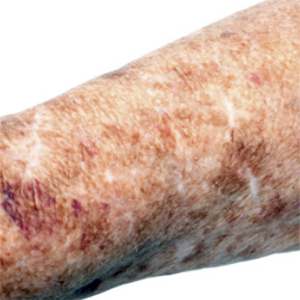Attitudes among dermatologists regarding actinic keratosis treatment options

Accepted: 15 November 2021
HTML: 8
All claims expressed in this article are solely those of the authors and do not necessarily represent those of their affiliated organizations, or those of the publisher, the editors and the reviewers. Any product that may be evaluated in this article or claim that may be made by its manufacturer is not guaranteed or endorsed by the publisher.
Actinic keratosis (AK) is considered a precancerous lesion that can develop into invasive squamous cell carcinoma. Its prevalence is increasing, and it is estimated that it affects between 1% and 44% of the adult population worldwide. Advanced age, fair skin phototypes, and cumulative sun exposure are the main risk factors for AK. Therapies for AK consists of lesion-directed treatment (i.e., cryotherapy, curettage, electrocoagulation, and laser therapy) or field therapy [i.e., photodynamic therapy (PDT), 5-fluorouracil (5-FU), diclofenac sodium (DIC), imiquimod (IMQ), and ingenol mebutate (Ing Meb)]. The type of therapy chosen is determined by the number and location of AKs, the patient’s condition, and the patient’s tolerability and compliance. In this survey, we collected information from 110 Italian dermatologists about their knowledge and attitudes toward various AK therapeutic approaches. In our study, we discovered that cryotherapy and PDT are the most used treatments for AK, while surgery and laser therapy are the least commonly used. The most commonly used topical therapies are DIC and IMQ 3.75 percent cream, followed by IMQ 5 percent cream, Ing Meb, and 5-FU. The correct treatment for AK can be difficult to choose, but adherence to therapy is critical for good results. Given the high and continuing rise in the incidence of AK, dermatologists’ knowledge of various therapeutic approaches is critical.
Werner RN, Stockfleth E, Connolly SM, et al. Evidence‐and consensus‐based (S3) guidelines for the treatment of actinic keratosis–International League of Dermatological Societies in cooperation with the European Dermatology Forum–short version. J Eur Acad Dermatol Venereol 2015;29:2069-79.
Naldi L, Chatenoud L, Piccitto R, et al. Prevalence of actinic keratoses and associated factors in a representative sample of the Italian adult population: Results from the Prevalence of Actinic Keratoses Italian Study, 2003-2004. Arch Dermatol 2006;142:722-6.
Traianou A, Ulrich M, Apalla Z, et al. Risk factors for actinic keratosis in eight European centres: a case–control study. Br J Dermatol 2012;167:36-42.
Schmitz L, Kahl P, Majores, et al. Actinic keratosis: correlation between clinical and histological classification systems. . J Eur Acad Dermatol Venereol 2016; 30:1303–7.
Stockfleth E. The importance of treating the field in actinic keratosis. . J Eur Acad Dermatol Venereol 2017;31:8–11.
Goldenberg G. Treatment considerations in actinic keratosis. J Eur Acad Dermatol Venereol 2017;31:12–6.
Puviani M, Galloni C, Marchetti S, et al. Efficacy of a film-forming medical device containing sunscreen (50+) and piroxicam 0.8% in actinic keratosis and field cancerization: a multicenter, assessor-blinded, 3 month trial. Curr Med Res Opin. 201l;33:1255-9.
De Berker D, McGregor JM, Mohd Mustapa MF, et al. British Association of Dermatologists’ guidelines for the care of patients with actinic keratosis 2017. Br J of Dermatol 2017;176:20-43.
Eisen DB, Asgari MM, Bennett DD, et al. Guidelines of care for the management of actinic keratosis. J Am Acad Dermatol. 2021;85:e209-33.
Lee CN, Hsu R, Chen H, et al. Daylight Photodynamic Therapy: An Update. Molecules 2020;25
Chetty P, Choi F, & Mitchell T. Primary care review of actinic keratosis and its therapeutic options: a global perspective. Dermatol Ther, 2015;5:19-35.
Newlands C, Currie R, Memon, et al. Non-melanoma skin cancer: United Kingdom National Multidisciplinary Guidelines. J Laryngol Otol 2016;130:S125-32.
Zane C, Facchinetti E, Rossi MT, et al. Cryotherapy is preferable to ablative CO 2 laser for the treatment of isolated actinic keratoses of the face and scalp: a randomized clinical trial. Br J of Dermatol 2014;170:111421.
Dianzani C, Conforti C, Giuffrida R, et al. Current therapies for actinic keratosis. Int J Dermatol 2020;59:677-84.
Ezzedine K, Painchault C, & Brignone, M. Use of complete clearance for assessing treatment efficacy for 5-fluorouracil interventions in actinic keratoses: how baseline lesion count can impact this outcome. J Mark Access Health Policy, 2020;8:1829884.
Dohil, MA. Efficacy, Safety, and Tolerability of 4% 5-Fluorouracil Cream in a Novel Patented Aqueous Cream Containing Peanut Oil Once Daily Compared With 5% 5-Fluorouracil Cream Twice Daily: Meeting the Challenge in the Treatment of Actinic Keratosis. J Drugs Dermatol 2016;15:1218–24.
Costa C, Scalvenzi M, Ayala F, et al. How to treat actinic keratosis? An update. J Dermatol Case Rep 2015;9:29.
Ricci F, Tambone S, Neri L, et al. Real-life efficacy and safety of ingenol mebutate for the treatment of actinic keratosis of the face and scalp: A single arm retrospective study. J Dermatolog Treat 2016;27:525–30.
Elías I, Ortega-Joaquín N, de la Cueva P, et al. Cost-Effectiveness and Cost-Utility Analysis of Ingenol Mebutate Versus Diclofenac 3% and Imiquimod 5% in the Treatment of Actinic Keratosis in Spain. Actas DermoSifiliogr 2016;107:498-508.
Tzogani K, Nagercoil N, Hemmings RJ, et al. The European Medicines Agency approval of ingenol mebutate (Picato) for the cutaneous treatment of non-hyperkeratotic, non-hypertrophic actinic keratosis in adults: Summary of the scientific assessment of the Committee for Medicinal Products for Human Use (CHMP). Eur J Dermatol 2015;24:457-63.
Moscarella E, Di Brizzi EV, Casari A, et al. Italian expert consensus paper on the management of patients with actinic keratoses. Dermatol Ther 2020;33:e13992.
Heppt MV, Leiter U, Steeb T, et al. S3 guideline for actinic keratosis and cutaneous squamous cell carcinoma–short version, part 1: diagnosis, interventions for actinic keratoses, care structures and quality‐of‐care indicators. J Dtsch Dermatol Ges 2020;18:275-94.
Dirschka T, Gupta G, Micali G, et al. Real-world approach to actinic keratosis management: practical treatment algorithm for office-based dermatology J Dermatolog Treat 2017;28:431-42.
PAGEPress has chosen to apply the Creative Commons Attribution NonCommercial 4.0 International License (CC BY-NC 4.0) to all manuscripts to be published.





 https://doi.org/10.4081/dr.2022.9392
https://doi.org/10.4081/dr.2022.9392



